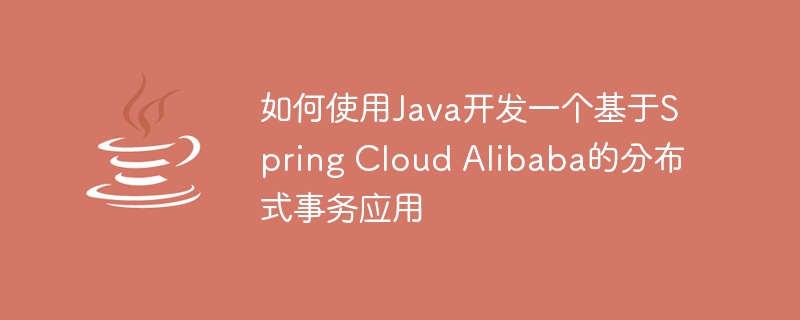Home >Java >javaTutorial >How to use Java to develop a distributed transaction application based on Spring Cloud Alibaba
How to use Java to develop a distributed transaction application based on Spring Cloud Alibaba
- PHPzOriginal
- 2023-09-21 13:13:41664browse

How to use Java to develop a distributed transaction application based on Spring Cloud Alibaba
Summary:
Distributed transactions are processed in a distributed system A mechanism for multiple sub-transactions to ensure that these sub-transactions either all succeed or are all rolled back. In a microservice architecture, distributed transactions become a challenging problem due to the mutual calls between services. Spring Cloud Alibaba is a microservice development framework based on Spring Cloud, which provides a comprehensive set of distributed transaction solutions. This article will introduce how to use Java to develop a distributed transaction application based on Spring Cloud Alibaba and provide specific code examples.
- Introducing dependencies
Before using Spring Cloud Alibaba for distributed transaction development, we first need to introduce the corresponding dependencies. Add the following dependencies to the project's pom.xml file:
<dependency>
<groupId>org.springframework.cloud</groupId>
<artifactId>spring-cloud-starter-alibaba-seata</artifactId>
</dependency>- Configuring Seata
Seata is a distributed transaction solution in Spring Cloud Alibaba. We need to configure Seata related information in the application configuration file. Add the following configuration to the application.properties or application.yml file:
# 启用Seata的自动代理 spring.cloud.alibaba.seata.tx-service-group=my_tx_group # Seata的注册中心地址 spring.cloud.alibaba.seata.registry.type=consul spring.cloud.alibaba.seata.registry.address=127.0.0.1:8500
- Implementing distributed transactions
Next, we start to implement a simple distributed transaction example . Let's say we have two microservices: an order service and an inventory service. When an order is created, we need to deduct the corresponding inventory at the same time. In order to implement distributed transactions, we need to use the @GlobalTransactional annotation provided by Seata. Add the following annotation to the order creation method of the order service:
@GlobalTransactional
public void createOrder() {
// 扣除库存的逻辑
deductStock();
}Also add the @GlobalTransactional annotation to the inventory deduction method of the inventory service:
@GlobalTransactional
public void deductStock() {
// 扣除库存的逻辑
}- Implement local transactions
In the above example, we used Seata to manage distributed transactions. But in reality, we still need to implement local transaction logic in each microservice. Since Seata supports multiple distributed transaction modes, we can choose the appropriate mode to implement local transactions.
The order service and inventory service in the example can use JdbcTemplate or MyBatis to operate the database. We define a local transaction method in each service and mark it with the @LocalTransactional annotation:
@LocalTransactional
public void createOrderTx() {
jdbcTemplate.update("INSERT INTO orders (order_id, user_id, amount) VALUES (?, ?, ?)", orderId, userId, amount);
}
@LocalTransactional
public void deductStockTx() {
jdbcTemplate.update("UPDATE stock SET amount = amount - ? WHERE id = ?", amount, stockId);
}- Testing distributed transactions
Now we can test our Distributed transaction applications. In the test code, we create an order and then assert whether the status of the order and inventory is as expected:
@Test
public void testCreateOrder() {
// 创建订单
orderService.createOrder();
// 断言订单状态
Order order = jdbcTemplate.queryForObject("SELECT * FROM orders WHERE order_id = ?", new OrderRowMapper(), orderId);
assertNotNull(order);
assertEquals(userId, order.getUserId());
assertEquals(amount, order.getAmount());
// 断言库存状态
Stock stock = jdbcTemplate.queryForObject("SELECT * FROM stock WHERE id = ?", new StockRowMapper(), stockId);
assertNotNull(stock);
assertEquals(originalAmount - amount, stock.getAmount());
}Summary:
This article introduces how to use Spring Cloud Alibaba to develop a distributed transaction-based Applications. By introducing Seata dependencies and adding @GlobalTransactional or @LocalTransactional annotations on the key methods of each microservice, we can build a reliable distributed transaction application based on Spring Cloud Alibaba. In actual projects, you may also need to handle more complex distributed transaction scenarios, such as distributed locks, message queues, etc. I hope this article has provided some help for you to understand and use distributed transactions.
The above is the detailed content of How to use Java to develop a distributed transaction application based on Spring Cloud Alibaba. For more information, please follow other related articles on the PHP Chinese website!

